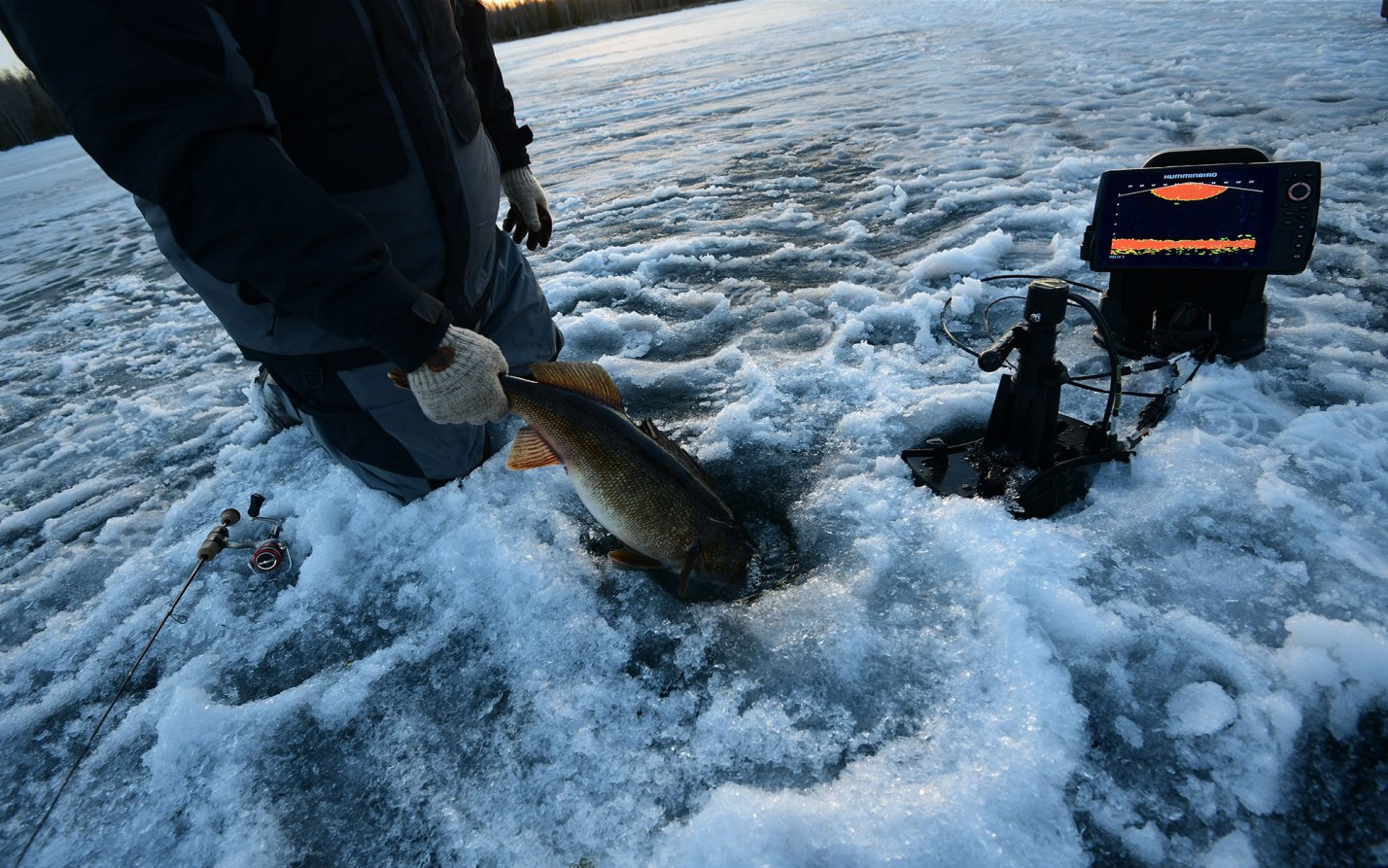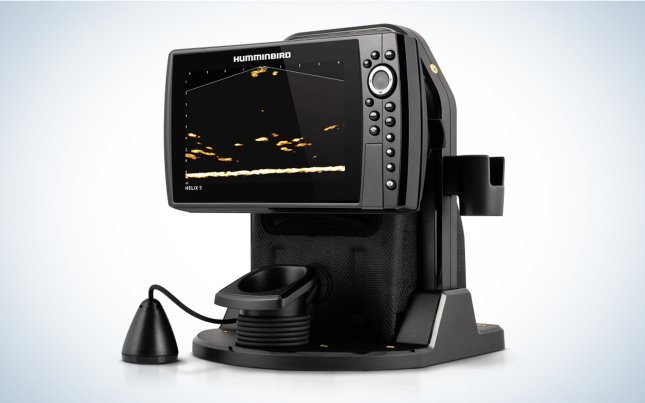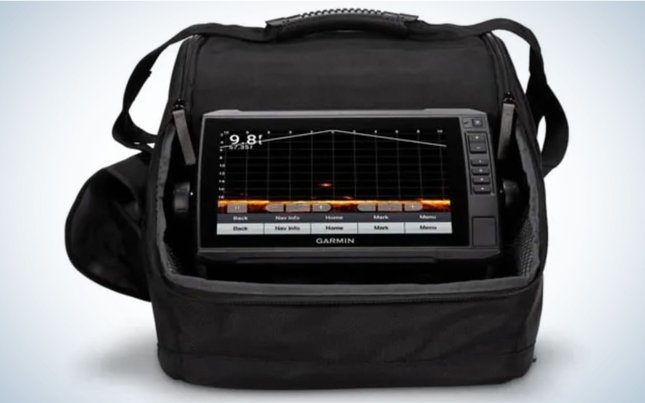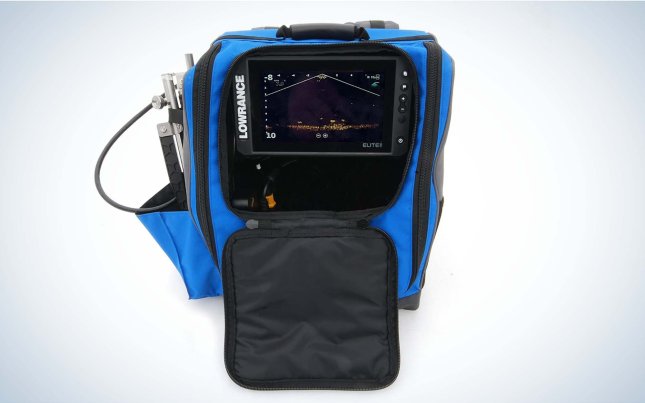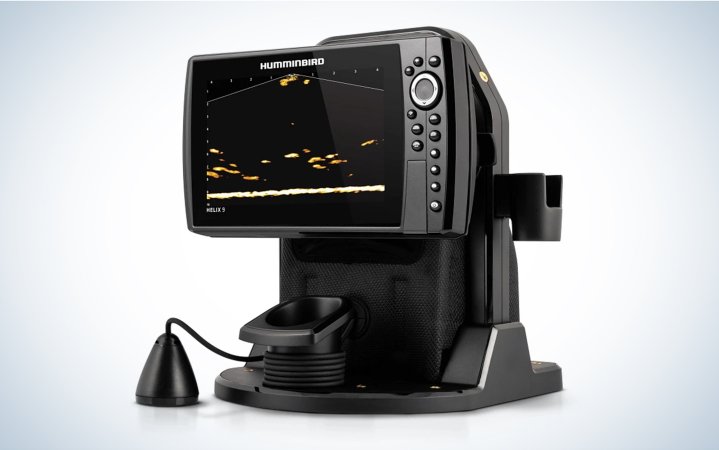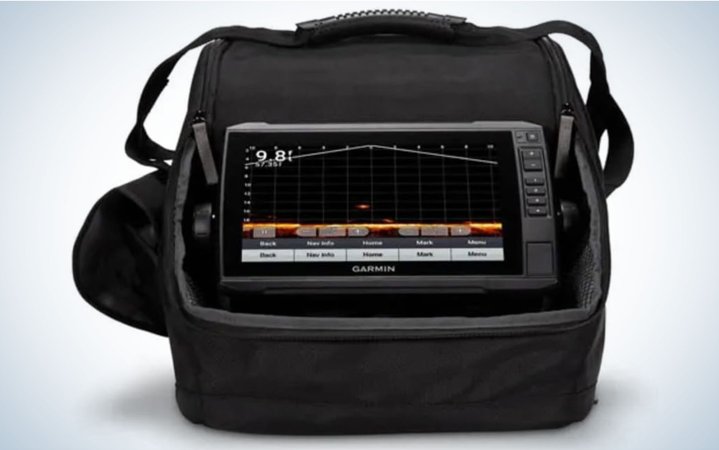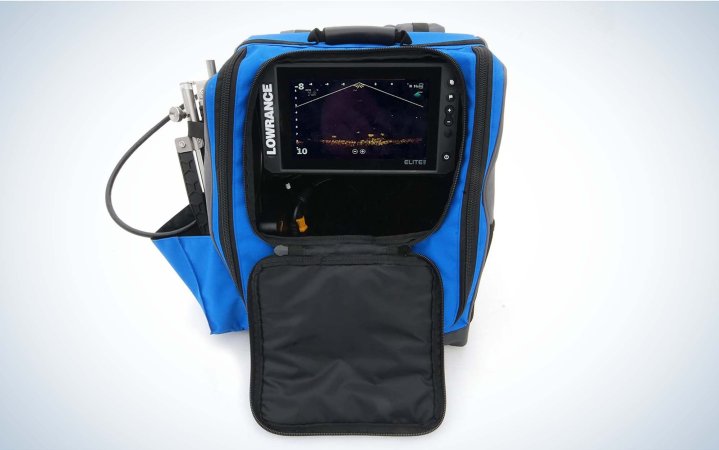We may earn revenue from the products available on this page and participate in affiliate programs. Learn More ›
Forward facing sonar might feel new, but it’s actually been around for years.
During the early 2000s, Gold Medal World Ice Fishing Champion Tony Boshold attached his flasher transducer to a wooden stake and would rotate the make-shift contraption in a circle to see fish at a distance around the periphery of the hole. Although he admits he wasn’t the first to try the technique, Boshold quickly adopted the sonar hack, leading to top finishes on the North American Ice Fishing Circuit.
Around the same time, a sonar company called BottomLine launched the first side-looking sonar units—the Fishin’ Buddy and Tournament Master SF3 Fishfinder—which would display fish and lures 75 feet off the side of the boat on a rudimentary black and white LCD screen.
Now every major sonar manufacturer offers some form of forward-looking sonar with the technology evolving every year.
With the help of veteran NAIFC ice tournament competitor, Shawn Bjonfald, several fishing buddies, and family, we put the top three forward-facing ice sonar combos through paces from December 2022 until March 2023. We also talked with ice anglers who use forward facing sonar and product experts.
- Best Overall: Humminbird Ice Helix 9 MSI+ GPS G4N MEGA Live Bundle
- Best Image Definition and Distance: Garmin LiveScope Plus Ice Fishing Bundle LI
- Best Designed and Most Affordable: Lowrance Elite FS 9 and ActiveTarget Explorer Series Pack
How We Tested Forward-Facing Ice Fishing Sonars
We tested the combos on a variety of waters, from the fertile lakes of west-central and northern Minnesota to metropolitan fisheries. We also used the units at a couple of community tournaments, teaching kids about the new technologies. Along the way, we searched for willing walleyes, bluegills, perch, crappies, and trout–pretty much anything that would bite.
The first thing we discovered? There’s a lot going on under the surface. It’s hard to believe the amount of forage roaming on some lakes—schools of baitfish in the thousands just cruising around.
Secondly, all three models work great for locating fish off in the distance, as well as watching your bait directly below the hole and real-time fish response.
Image and Clarity
All three models have various modes, including the two most-used modes: down- and forward-looking. For scouting a place to ice fish, you’ll want to set your chosen unit to forward-looking to scan large areas of hard water and find where fish are located. Then, once in the vicinity of those marked fish, you can either change to down mode or continue fishing in forward-looking mode, which will allow you to monitor more than one hole at a time when fishing with others and watch fish come in from a distance to investigate your bait.
Switch to down mode when fishing in deeper waters—like 35 or 40 feet or more. For anglers jigging deep-water perch, lake trout, whitefish or tullibees, that’s the perfect mode. We didn’t test the units deep, but have heard from experts that most units cap out at about 80 feet. For waters deeper than that, you’re going to want to go back to a high-powered flasher or consider what a lot of deep-water lake trout jiggers have started using—and that’s Garmin’s LiveScope XR System with GLS 10 black box and LVS62 transducer. Specifications cite a maximum operating down- and forward-looking depth range of 500 feet in freshwater.

They all performed well, revealing baits and fish directly below the hole, especially with a tweak of contrast and sensitivities here or there. And, as new software updates are constantly released, the image quality is only getting better. I think a lot of it comes down to picking the color palette that best suits your eyes—and setting the down-looking depth range to about 10 feet deeper than the actual depth for the best pixel resolution.
Where the units differed most was with what’s called latency—and that’s the time between moving your rod tip and watching bait response on the screen. Again, software is always improving this aspect, too, but at the time of our testing last winter, the unit with quickest, near real-time response was Garmin LiveScope, with Humminbird MEGA Live nearly as fast, and Lowrance Active Target demonstrating the most lag time.
This means you shouldn’t rely solely on what you’re seeing on the screen to determine when to set the hook. You might be jigging a couple feet above a crappie, watch them rush in to eat it, and by the time the jig and fish return coincide the fish has actually already inhaled the bait. Glance to your rod tip or spring bobber and use that as the real indicator of when to set the hook.
Distance Clarity
Building on prominent Canadian ice angler Jay Siemens’ tests, we tested distance performance of the three forward-facing units similar to what he did with an average “eater-size” walleye, often the target of ice anglers.
To test what an eater walleye would look like while scanning a lake, we pinned a large, dead, 18-inch decoy sucker to a quick-strike rig and deployed it via a tip-up nine feet down over an 18-20 foot flat at numerous measured distances. Since our test fish was dead, the only issue we ran into was having to orient the sucker slightly vertical to get it down and up out of each test hole; hence the images appearing vertical rather than horizontal.
Read Next: The Best Ice Fishing Fish Finders
One hole was used to deploy the forward-facing transducer pole of each unit, and test holes were drilled at 20, 45, 60, 70, 90, 100, 110, 120, 140, and 200 feet to deploy the decoy sucker.
Both the Garmin and Lowrance units claim a distance reading specification of 200 feet, while Humminbird is rated to read out 150 feet.
We then proceeded to test each unit for image recognition and clarity in its forward-looking mode.
Distance Testing Results
| Distance | Garmin LiveScope Li Ice | Humminbird MEGA | Lowrance ActiveTarget |
| 20 Feet | Fish image was very clear | Fish image was very clear | Fish image was very clear |
| 45 Feet | Very clear | Very clear | Very clear |
| 60 Feet | Very clear | Very clear | Very clear |
| 70 Feet | Clear | Good | Good |
| 90 Feet | Good with gain set to 85 percent | Good with Sensitivity maxed out | Good with Contrast maxed out |
| 100 Feet | Fish was identifiable with transducer pointed at it | Could discern fish with Sensitivity maxed out | Could discern fish with Contrast maxed out |
| 110 Feet | Fish was identifiable with transducer pointed at it | No fish image | Could discern fish with Contrast maxed out |
| 120 Feet | Fish image starting to break up a bit; distance set to 132 feet | No fish image | A slight flicker of target with Contrast maxed out |
| 140 Feet | Hard to pick up even with gain maxed out | No fish image | A very slight flicker of target with Contrast maxed out |
| 200 Feet | No fish image | No fish image | No fish image |
Humminbird MEGA Live Ice Bundle with Sensitivity to 15; Contrast to 10; Dynamic Contrast to Balanced; Forward Display to 40-degrees; Distance to 100 feet (for starters); Depth: 20 feet; Color Palette: “Minnesota Vikings” purple and gold.
Lowrance ActiveTarget Bundle with Contrast to 85 percent; Noise Rejection to Low; Distance to 100 feet (for starters); Depth: 20 feet; Color Palette: 1: Green/Black and 5: Light Amber.
Do you really need to look out 100 feet or more to break down a lake and find fish? Not really. Distances of 50 to 100 feet are pretty far, especially when you consider that you only need to drill one hole, look out that sub-100 foot distance, walk a bit more, drill another hole and shine the transducer in all directions around the hole. You can still cover a lot of hard water super-fast even if units don’t spot fish all that well at super-far distances. Maybe that’s where the new Garmin XR system would come in with its claimed 500-feet for forward-looking power. And I’m sure Humminbird and Lowrance are working on increased distances, too. For pro ice anglers, sure, it’s about maximizing pre-fishing time and locating fish as quickly as possible. But for the rest of us, even at current distances, the technology is amazing.
Best Forward-Facing Ice Sonar: Reviews & Recommendations
Best Overall: Humminbird Ice Helix 9 MSI+ GPS G4N MEGA Live Bundle
Best Overall Forward-Facing Ice Sonar Unit
Humminbird Ice Helix 9 MSI+ GPS G4N MEGA Live Bundle
Pros
- Quick boot-up time
- Relatively lightweight and no heavy black box required
- Customizable settings
- Amazing fish and bait clarity
- Can be used on open water too
Cons
- Complicated directions and assembly
- Missing minor assembly hardware
- No enclosed bag with pockets
- Some latency finding GPS Fix/MEGA Live transducer
- Separate power and transducer cords vs. one combined cable
- Front/rear cable and transducer management covers hard to keep in place
- Won’t accept SD cards over 32GB or SDXC format for software updates
- Only 2-Year Limited Warranty
Key Features
- Humminbird ICE Helix 9 MSI+ GPS G4N sonar unit (9-inch screen)
- 1024H x 600V pixel LCD display
- Keypanel/button operation
- Range: 150 feet (down & forward) per Humminbird specs
- Frequency: Fixed 1050 kHz
- Beam: 20-degrees x 120-degrees
- Built-In Humminbird Basemap
- AutoChart Live ICE to create real-time 1-foot map contours
- Built-in ice flasher/dual spectrum CHIRP ice sonar; transducer included
- CHIRP Interference Rejection: 6 settings for clear views in all modes
- Adjustable Sonar Zoom: 2X on flasher; 16X on 2D Sonar
- Jig charge mode
- Ice Shuttle w/master switch, quick-connect SAE power cables, large handle, multiple mounting points, 2 rod holders, cable & transducer management, battery cover, & silicone screen cover
- Sturdy, 3-sectioned MEGA Live transducer pole for varying ice depths
- NORSK 20Ah lithium battery w/ 2 USB ports & charger
- IPX7 waterproof rating
While priced high, you get numerous extras with the Humminbird Ice Helix 9 MSI+ GPS G4N MEGA Live Bundle. You get an ice transducer (besides the MEGA Live transducer) for use as a flasher or in 2D Sonar mode, and a high-quality NORSK 20Ah lithium battery and charger. The battery alone retails for $209.99.
Two things that could be improved. First, the unit came completely disassembled. Unlike the Garmin and Lowrance, assembling the unit took a few hours.
Given the price, I think the MEGA Live ICE Combo should come stock with a LakeMaster VX Premium mapping card coupon. However, with the affordable $24.99 annual plan for VX Premium mapping through Humminbird’s new One-Boat Network app, that’s probably a moot point.
But, the unit makes up for those cons with its performance. Over the course of use, we discovered the Humminbird Ice Helix 9 MEGA Live provides quality imaging in both forward- and down-looking modes. Set in forward mode in the 40- to 70-feet range, we located weed edges and suspended panfish over open water. We did not test in landscape mode. Settings included Dynamic Contrast set to Balanced; Sensitivity set between 10 and 15; Contrast set to 10.
Once fish were located and we drilled over them, we switched the transducer to Down mode. From 30 feet to as shallow as 4.5 feet, we were able to watch fish react to our baits in real-time, moving in from the sides—often in pairs or larger pods—to investigate our baits.
Read Next: The Best Fish Finders
Some pods of fish were spookier than others, and you’d have to follow them with MEGA Live in forward-mode, drilling new holes to stay on top of the bite. But we got visual evidence as far as what jigging cadences triggered the fish to bite. In that regard, the technology is very educational re: fish behavior.
While there are a lot of color palettes to choose from, we particularly like Humminbird’s #2 Minnesota Vikings black/purple/gold, #5 green-black palette, and #8 black/red/green palette for their contrast and definition. But it’s all a matter of what colors best suit your eyes and light conditions.
A great value to the Humminbird MEGA Live Ice combo is its networking capabilities with other Humminbird and Minn-Kota products in the One-Boat Network, allowing use during the open-water if removed from the ice shuttle and the MEGA Live transducer reconfigured for trolling motor, pole/mount, or new TargetLock trolling motor integration.

LakeMaster VX Premium mapping is another reason MEGA Live ranks best overall. At least for fishing in Minnesota, LakeMaster maps are hard to beat, especially with new features like four depth highlights with customizable color palettes, built-in SmartStrike, 2D shaded relief, and aerial imagery—as well as a super impressive mapped lake list. At least for now, LakeMaster cards are only compatible with Humminbird units, although any angler can affordably purchase the One-Boat Network app to take advantage of the company’s mapping via cellphone without networking directly with their sonar unit.
In terms of the included transducer pole, it is a bit cumbersome and heavy. Could improvements be made there? Certainly. If fishing on foot, you might want to look at a third-party tripod pole that’s lighter and collapsible—but if fishing on an ATV or snowmobile, the Humminbird pole is just fine since can easily be stowed in something like a Kolpin auger bracked or DIY system for moving spot to spot, scouting for fish.

Lastly, the MEGA Live ice bundle is also compatible with the MEGA Humminbird 360 with an Ice Adapter Kit. This technology—even more than Forward-Facing units in landscape, perspective, or scout mode, clearly displays fish and structure in a full circle that spans 125-feet in every direction an entire 360-degrees around the hole, providing bright and crisp readings of underwater structure like weed lines, hard and soft bottom transitions, rock piles, manmade fish cribs, and fish.
What MEGA 360 really excels at that forward-facing sonar doesn’t do all that well, is reveal bottom-hugging fish, which appear like grains of rice on the bottom—especially over dark, soft bottom. Used in tandem with forward-facing sonar, you’ve got a very deadly system that’s probably unbeatable. Drop 360 to get a lay of the land and mark waypoints, then use your forward-facing sonar in forward mode to dial in closer, ultimately drilling right on top of structure or fish in down-looking mode.
Best Image Definition and Distance: Garmin LiveScope Plus Ice Fishing Bundle LI
Best Forward-Looking Sonar Image Definition and Distance
LiveScope Plus Ice Fishing Bundle LI
Pros
- Incredibly clear and crisp imaging
- No lag in bait response when jigging
- User mapping via Quickdraw
- ActiveCaptain app that allows wireless software downloads
- Little interference/noise
- Intuitive touch-screen menu system
- 15 color palette choices
- 3-year warranty
Cons
- Cost: $3499.99
- 4-pound-plus black box
- Total weight of system: 28 pounds
- Bulky, tubular, 3-sectioned plastic transducer pole
- Difficulty updating software via SD card or Garmin ActiveCaptain app
- Only 6 color palettes
- 2D ice transducer not included
- Only accepts hard-to-handle microSD cards
- Protective cover not included ($14.99)
Key Features
- Touch-screen Garmin ECHOMAP UHD 93sv sonar/chartplotter unit (9-inch screen)
- 800H x 480V pixel WVGA/NP touch-screen with keyed-assist display
- LiveScope PLUS LVS34 transducer (Forward, Down, & Perspective modes)
- GLS10 LiveScope black box
- Range: 200 feet (down and forward) per Garmin specs
- Frequency: 530-1110 kHz
- Beam: 20-degrees x 135-degrees
- Built-in LakeVu g3 maps (integrated Garmin & Navionics data); also supports Garmin Navionics+/Vision+
- Quickdraw for user/community mapping sharing
- Garmin ActiveCaptain app networking
- Built-in ice flasher (requires GT10HN-IF transducer purchase, $169.99)
- Built-in ClearVu and SideVu sonar
- Lightweight, unbranded 16.5 Ah lithium battery
- 1.5 amp draw without black box
- Plastic, tubular pole and transducer bracket
- Carrying case with two pockets
- IPX7 waterproof rating
- Sonar recording
- 28 pounds
- Value for year-round use
Awarded Best in Ice Fishing at ICAST 2022, the LiveScope Plus Ice Fishing Bundle LI, is an amazing piece of fish-finding technology. From what long-time Garmin users tell us, in terms of image clarity, it’s an improved version of Panoptix and the previous-generation LiveScope ice bundle with LVS32 LiveScope transducer.
First, there’s very little assembly required out-of-the-box. You have to put the pole and transducer together—that’s about it.

While lightweight, the gray, tubular plastic transducer pole isn’t super ice-worthy. Our test unit broke after a couple uses and required a Gorilla Tape fix.
In terms of mapping, built-in LakeVu g3 maps (integrated Garmin and Navionics data) mapping was pretty accurate where we fished and integration with the Garmin ActiveCaptain smartphone app offers lots of features. The unit als supports Garmin Navionics+/Vision+.
The graph boots up quickly and the menu system is easy to navigate via touchscreen. Once deployed, we immediately noticed the crisp, clear sonar readings—the argument many anglers have made for choosing Garmin LiveScope over the competition.
In Down mode our baits showed up crisp and clear, as did the bluegills and crappies that moved in on our small tungsten jigs—which also showed up amazingly well. The unit also seems to have the best real-time response when fishing, revealing jig-strokes without any latency.
Read Next: The Best Portable Fish Finders
We later played with the settings, adjusting Color Gain to 65; Noise rejection to High; Gain at 75; and TVG (Time Variable Gain) Off.
In terms of distance and scouting fish on the ice, Garmin LiveScope Plus located and provided a return of the submerged decoy-sized sucker from up to just over 100 feet away; the target started to greatly diminish between 100 and 120 feet.
Comparing the three different forward-facing combos, Garmin LiveScope Plus with LVS34 transducer has the best, all-around forward- and down-looking image quality and response time.
*Note: We did experience an issue with Garmin’s unbranded 12V 16.5Ah lithium battery not providing a full-day of power to the unit and had to swap out batteries to a spare lithium battery. It should be noted that retailers like Reed’s are now packaging their LiveScope Ice Sonar bundles with NORSK lithium batteries – the same battery used by Humminbird in their unit – which had zero issues with running for up to two full days of fishing on a single charge. If you need to fish longer than a weekend on a single charge, you might consider stepping up from a 12 volt 20Ah battery to 32Ah.
Best-Designed and Most Affordable: Lowrance Elite FS 9 and ActiveTarget Explorer Series Pack
Best-Designed and Most Affordable Forward-Facing Ice Sonar Combo
Lowrance Elite FS 9 & ActiveTarget Explorer Series Pack
Pros
- Less expensive than competitors
- Quick boot-up time
- Slightly narrower sonar beam allows more object definition at farther distances in Forward view
- Crisp, clear imaging
- Space-saving, collapsible, tripod-style live sonar transducer pole fits into backpack
- Intuitive, touch-screen menu system
- Very easy to transport via backpack-style bag
- Best-designed, collapsible, tripod-style transducer pole
- 2-Year Warranty + 3 additional years to upgrade
Cons
- Slight latency jigging in Down view
- Touch menu system can be slightly confusing
- Occasional interference over hard bottom
- 4-pound-plus black box
- 2D ice sonar transducer not included
- Only accepts hard-to-handle microSD cards
- Recommended operation only down to 5-degrees Fahrenheit
- The Lowrance comes pretty much assembled and ready-to-fish.
Key Features
- Touch-screen Lowrance Elite FS 9 sonar unit (9-inch screen)
- 800H x 700V touch-screen w/keyed assist display
- ActiveTarget Live Sonar Transducer (Forward, Down, & Scout views)
- Beam: 18-degrees x 135-degrees
- Range: 200 feet (down and forward) per Lowrance
- Frequency: 550-1110 kHz
- ActiveTarget Module
- Custom wiring harness and master power switch
- 2-foot ethernet cable
- Built-in C-MAP Contour+ Mapping
- Built-in Downscan, Sidescan, & 2D Sonar
- 24Ah Dakota Lithium battery with dual USB charging ports and voltage meter
- Metal, collapsible/extendable tripod-style transducer pole
- Premium Explorer backpack-style bag with shuttle frame
- Screen recording via 32 Gb/smaller SD card or Wi-Fi and Lowrance app
- 2 amp power draw without black box
- 13 pounds
- IPX7 waterproof rating
- Value for year-round use
The ActiveTarget bundle design is super-smart—the Lowrance Elite FS 9 sonar unit, black box, all wiring, and folding, tripod-style transducer all fit together in an ergonomic backpack-style bag with shoulder straps. For anglers humping gear on foot – or for tracking schools of fish once the snow machine is parked – this carrying system is ideal. Definitely the best design of all three shuttle combos.
With regards to the units built-in C-MAP Contour+ Mapping, the level of accuracy was sufficient for the waters we fished.
Read Next: The Best Ice Fishing Shelters, Tested and Reviewed
Once deployed, the ActiveTarget unit booted up quickly and initial set-up was pretty easy via the touchscreen menu-system. The factory presets provided a clear image in forward- and down-view but we made a few tweaks along the way. For most situations, Contrast was set at 85 percent; stable view ON; and noise rejection set to LOW yielded the sharpest, most clear imaging.
The Lowrance didn’t seem quite as good as the Garmin and Humminbird units in terms of image quality. We also experienced some time delay and latency when jigging and occasional bands of interference to the sides, especially over harder bottoms.

My understanding is Lowrance has made several significant improvements over the tested ActiveTarget unit with the release of the ActiveTarget 2.
We had no issues with the Lowrance-supplied 24Ah Dakota Lithium battery but did not fish it more than 12 hours before recharging.
How to Choose a Forward-Facing Ice Sonar Unit
The first thing to consider when purchasing a forward-facing ice sonar combo is keeping the unit in the family of marine electronics you operate in your boat.
At least as of now, you cannot network Humminbird, Garmin, and Lowrance units together. Because the forward-looking technology is close in terms of pros and cons, it’s best to pick a unit that you can also network with what you already have in your boat. That’s a cost savings in the long-run.
Secondly, you need to think about where and how you fish. Do you need to cover great expanses of water or ice to find fish? If so, the forward-looking attributes to the combo might be more important to you. But range also matters for the depth of water you’ll be fishing. If you’re fishing lake trout, you may need the best depth penetration and image clarity possible for jigging deep fish. If you’re chasing roaming pods of fish, again, forward-looking attributes may be more important to you.
For most of us, we’re multi-species anglers who chase a variety of fish on lots of different-sized waters. After trying these three combos, the difference in forward-looking range and down-looking clarity is pretty negligible to me. What’s more important is if it will network with what I already have in my boat for open-water use.
Read Next: The Best Fish Finders under $1,000
Furthermore, I don’t really need to see out past 50- to 80-feet most of the time on the ice. I’ve typically keyed into high-probability areas with the use of HD lake mapping before I ever drill a hole so I’m not scanning vast water expanses.
In terms of down-looking imaging, they’re all pretty equal.
Lastly, in my opinion, mapping should be a significant consideration in product selection. If you’re fond of one particular brand of mapping for where you typically fish—and it matches the unit or units on your boat—that’s probably the forward-facing ice unit you should consider.
FAQs
While rated to see forward anywhere from 150 to 200 feet, most units work best set to 100 feet or under. Farther than that and targets are less visible and image quality drops off significantly.
Units are rated to work in depths from 150 to 200 feet, but work best well under the 100 foot mark. For 2024, sounds like Garmin XR, Lowrance Active Target 2, and new software updates for Humminbird MEGA Live increase these ranges, which should be of particular interest to deep-water ice anglers like those jigging lake trout.
Humminbird, Garmin, and Lowrance all have their merits, as mentioned above in the pros and cons and testing results. The “best” is what fits into your budget and the brand of sonar and mapping you already use. For example, you might be able to take a unit off your boat and simply purchase a kit with forward-facing transducer, cables, case, and lithium battery.
Yes, if for some reason you’d like a shuttle with additional features like USB-ports, 12V DC cigarette plug adapter, etc., these are being built by various companies across the U.S. and Canada. Same goes for bags and more compact forward-facing sonar transducer pole designs.
Final Thoughts on the Best Forward Facing Sonar for Ice Fishing
With passionate anglers on both sides, there’s an ongoing argument as to whether forward-facing sonar gives anglers an unfair advantage.
Like any new fish-finding technology, forward-facing sonar does speed up the time it takes to locate fish, but in the end, you still need to get them to bite.
What forward-facing sonar does better than just about any other fish-finding technology (besides underwater cameras) is educate anglers as to how fish react in real-time to bait choices, sizes, colors, and cadences. You can actually see how fish react to what you’re presenting—and if it works—allowing tweaks to presentations and cadences to catch more fish.

The big barrier at this point is the extraordinary cost of forward-facing units. Still, sales reveal anglers are willing to pay the money if it makes fishing with family and friends a more positive experience. My hope is that units become more compact and less expensive in the near future.
The important topic to consider with the advent of forward-facing sonar is angler stewardship.
For example, deep basin crappies (particularly older, bigger year classes) that were once hard to locate are now much easier to find, making them particularly vulnerable. Recent studies suggest that crappies caught deeper than 26 feet down in the water column die from barotrauma even if their air bladders are fizzed with a needle for release.
While most anglers may only keep their limit, anglers are still apt to sit over a school all day and catch dozens of fish for fun, never realizing that they are killing every crappie pumped out of the depths, despite their release.
Read Next: How to Read a Fish Finder
Forward-facing sonar has also had a huge impact in the muskie fishing world. The Professional Muskie Tournament Trail banned use of the technology in competition. With forward-facing sonars, muskie anglers are able to drive around a lake, spot big fish, and make targeted casts. At one particular event, forward-facing sonar allowed a competitor and co-angler to catch over a dozen fish in a series of pin-pointed casts to win the tournament. So much for muskies being the “fish of 10,000 casts”.
Still, used conscientiously, there’s a place for forward-facing sonar in fishing, although I’ve been slow to accept it. Part of the fun of fishing is the element of surprise.
So far, my experience has revealed that while it’s become easier and faster to locate fish on ice and open-water, there are times when fish on the screen simply don’t react—so it’s not necessarily the magic wand or tipping point many are convinced forward-facing sonar represents.
Ultimately, sonar manufacturers need to do a better job of telling the stewardship story, recommending when, how, and where to use the units in a way that doesn’t harm fisheries.
But it’s also up to anglers. So go out, have a good time, but don’t abuse the advantages this technology has given us over the sonar of yesteryear.
- Best Overall: Humminbird Ice Helix 9 MSI+ GPS G4N MEGA Live Bundle
- Best Image Definition and Distance: Garmin LiveScope Plus Ice Fishing Bundle LI
- Best Designed and Most Affordable: Lowrance Elite FS 9 and ActiveTarget Explorer Series Pack
